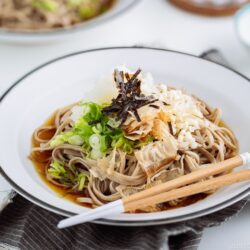
Everyone needs a quick meal that is fresh, nutritious, and delicious. Oroshi Soba (おろし蕎麦) meets exactly the criteria when I need to cook up a healthy meal fast for the family. It uses basic Japanese ingredients like dried soba noodles, dried bonito flakes, scallion, and daikon radish.
When you’re in a hurry, but still want something simple yet satisfying, Oroshi Soba is a recipe you can call on.
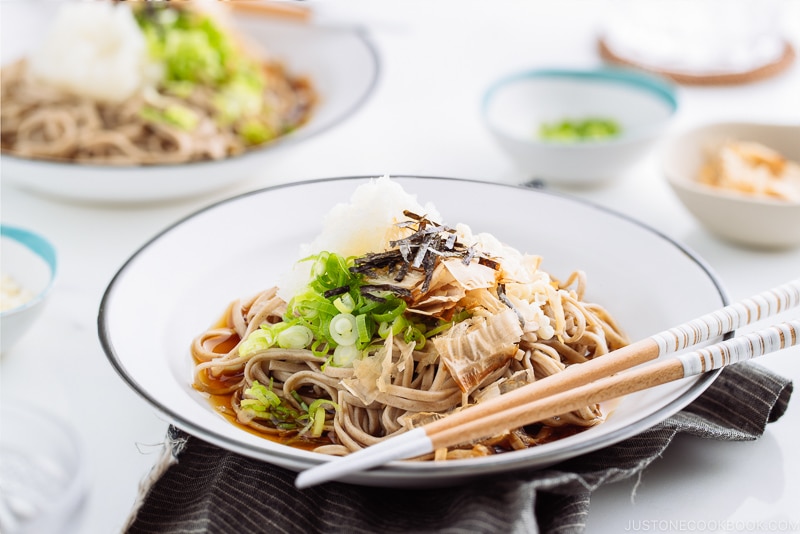
What is Oroshi Soba?
Oroshi Soba (おろし蕎麦) literally means “grated daikon buckwheat noodles.” It’s one of the popular soba noodle menus that you can find at noodle shops in Japan and it’s served hot or cold. The signature of this dish is the grated daikon on top of the noodles.
Many of you probably already know “soba” is a Japanese name for buckwheat noodles. If you’re not sure what is soba or what’s the difference between soba and udon noodles, you can read more here.
Now, “oroshi” means daikon oroshi (大根おろし), which is grated daikon in Japanese. Grated daikon gives a refreshing texture as well as a bit of spicy kick to the dish. We often serve grated daikon with deep-fried foods to lighten the dish. Some of the signature grated daikon dishes include Saikoro Steak, Shrimp Tempura, and Vegetable Tempura, Agedashi Tofu, Tamagoyaki, and Wafu Hambagu.
Where to Get the Best Soba Noodles
Once in a while, I get a question about my favorite brand of soba. To be honest, I didn’t particularly have one until since soba brands are pretty limited here in the U.S. (or outside of Japan in general). However, I was recently introduced to Shinshu Inaka Soba – Komoro Shichibei (信州田舎そば 小諸七兵衛) by Hoshino Bussan (星野物産).
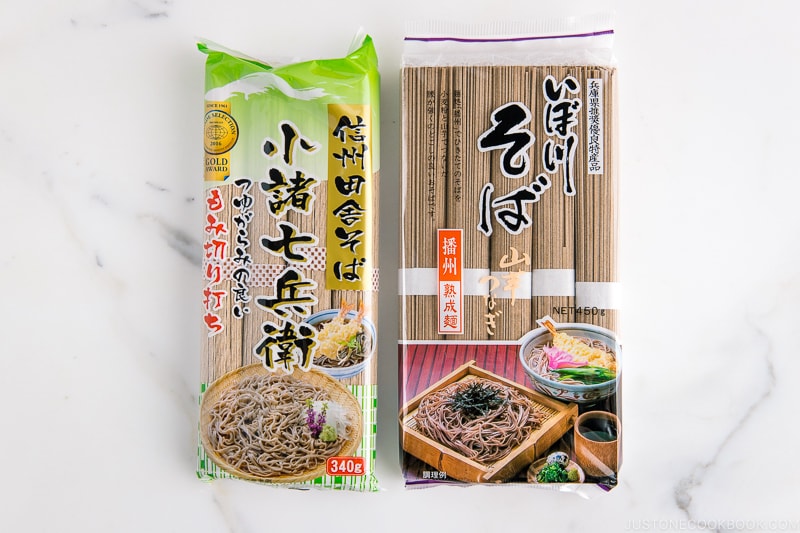
The noodles are a little bit wavy with a nice earthy flavor, and they have the absorbency to soak up the dipping sauce very well. Unlike some soba noodles that tend to develop a mushy, starchy exterior, Shinshu Inaka Soba has a remarkable good bite that stands out immediately. Luckily my local Japanese grocery store Nijiya Market started carrying this brand. If you spot this soba noodle at your local Japanese grocery store next time, grab one and give it a try.
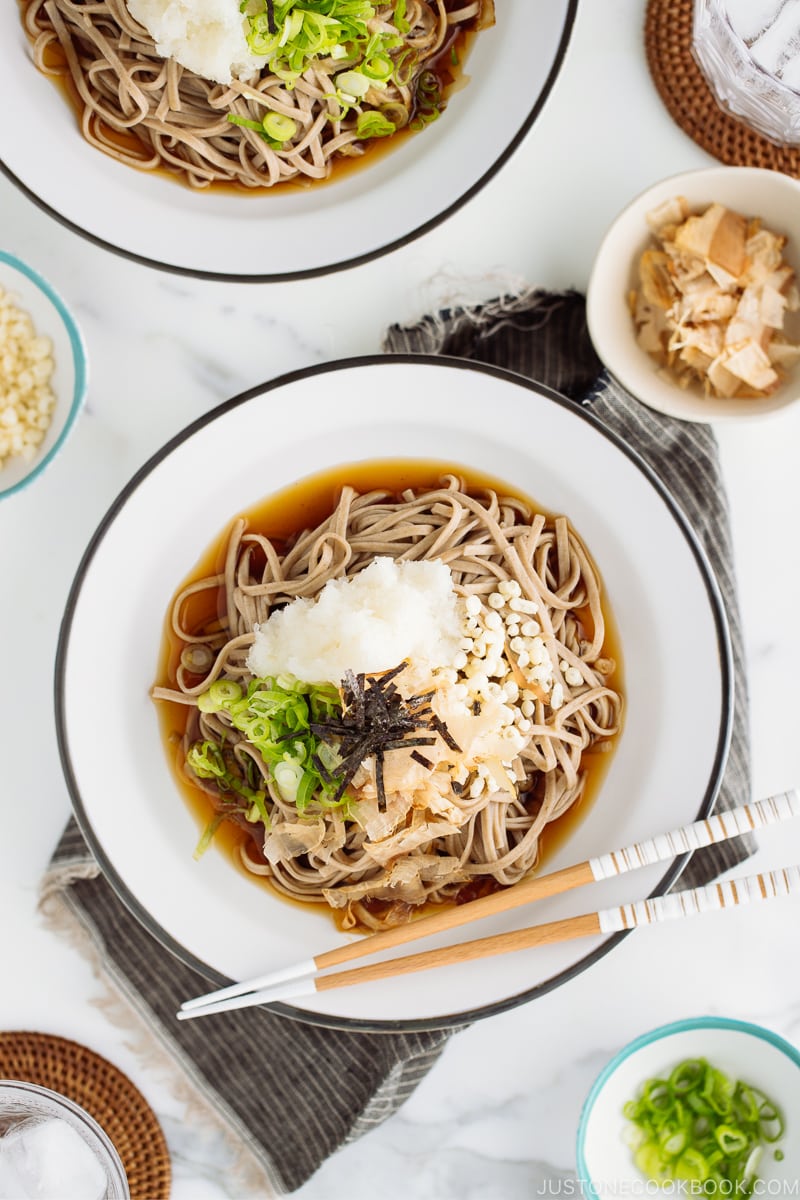
The Key Ingredient – Katsuo Dashi
For a simple recipe like this with minimal ingredients, it’s important to bring out the flavor from each ingredient. Here I used Katsuo Dashi (鰹だし)—Japanese soup stock made with dried bonito flakes. The intensity of katsuo dashi and the additional bonito flakes sprinkled on top provide lots of umami to this simple noodle dish.
It’s very easy to make Katsuo Dashi. You can make a big batch and use some of it to make miso soup for another meal.
How to Make It Vegetarian-Friendly
If you’re vegetarian or vegan, don’t worry. You can make the Japanese soup stock with umami-rich kombu or edible kelp. Kombu Dashi is also very easy to make. The key to extracting good flavor is to slowly bring the kombu to simmer on low heat, which allows the kombu to steep for a longer time.
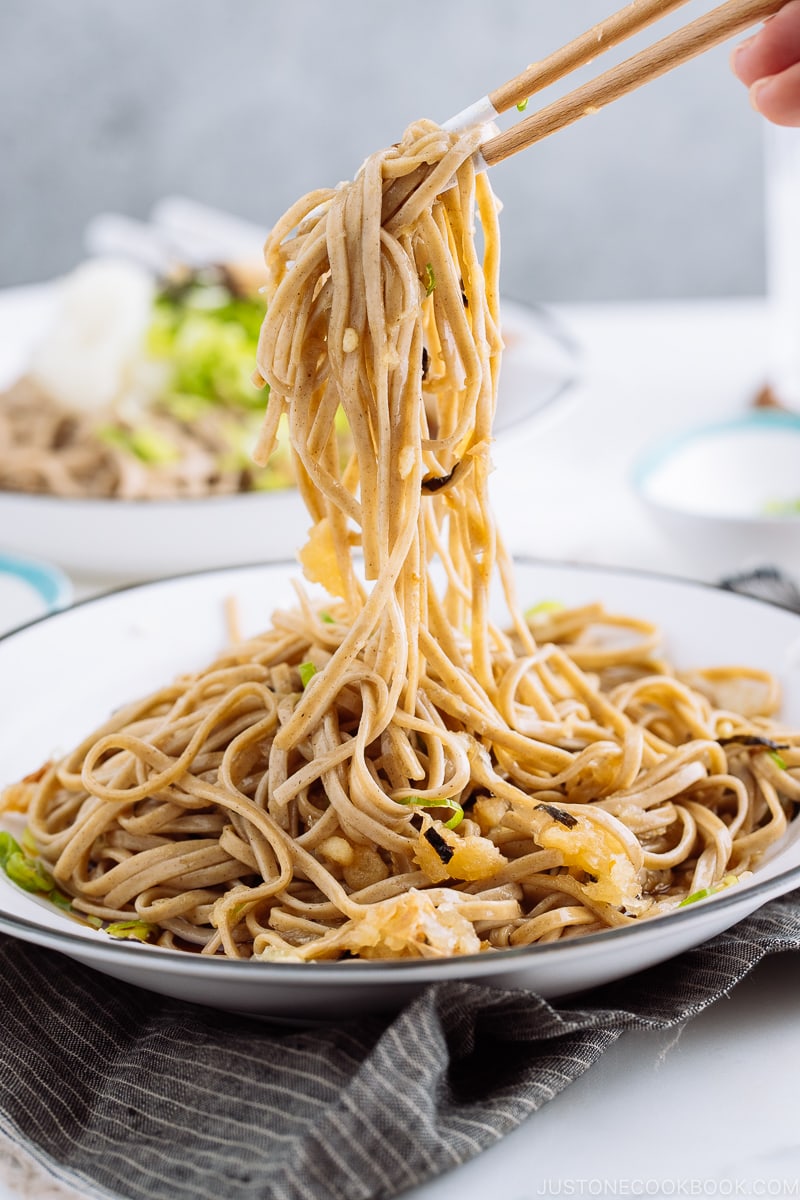
Echizen Oroshi Soba – Fukui Regional Dish
While I was researching online about typical Oroshi Soba in Japan, I learned that it is actually a regional dish in Fukui prefecture, located on the Japan Sea coast in the Chubu region of central Japan. I have never been to Fukui prefecture before, but Fukui prefecture which used to be called “Echizen” has the prefectural “representative food” called Echizen Oroshi Soba (越前おろしそば).
For Echizen Oroshi Soba, the soba noodles are handmade using local buckwheat, and the grated daikon is added to the dashi-based soup (In my recipe, I placed the grated daikon on top of the noodles). Before you eat, you would pour the chilled dashi soup containing grated daikon over the soba noodles.
The toppings are simple and similar to my recipe – katsuobushi and chopped scallion. What they focus on is the quality of soba noodles, the refreshing yet spicy daikon, and freshly shaved quality bonito flakes. It is a minimalist dish that allows each ingredient to shine.
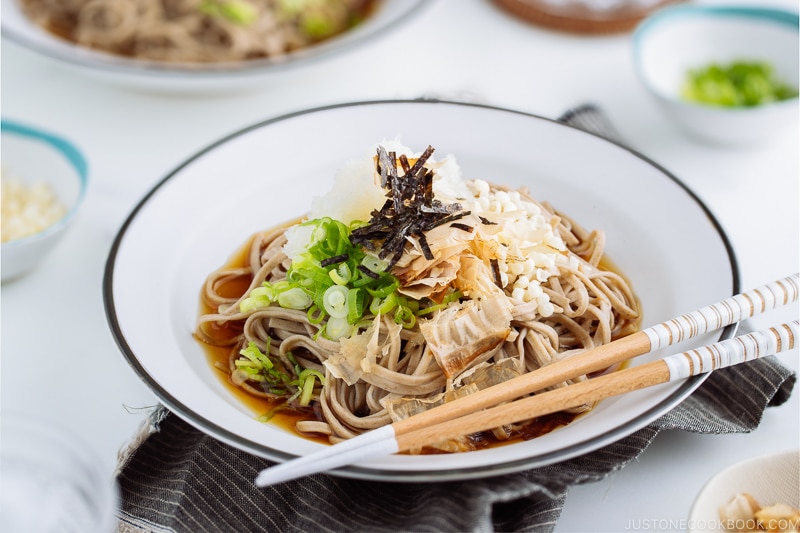
Wish to learn more about Japanese cooking? Sign up for our free newsletter to receive cooking tips & recipe updates! And stay in touch with me on Facebook, Pinterest, YouTube, and Instagram.
Oroshi Soba
Ingredients
- 6 oz dried soba noodles (buckwheat noodles)
- 7 oz daikon radish (2 inches, 5 cm)
- 1 green onion/scallion (for the topping)
- ½ cup katsuobushi (dried bonito flakes) (for the topping; skip for vegan/vegetarian)
- 3 Tbsp tenkasu/agedama (tempura scraps) (for the topping; optional)
- 1 Tbsp shredded nori seaweed (kizami nori) (for the topping)
For the Sauce
- 1½ cups water (for vegan/vegetarian, make Vegan Dashi)
- 1 cup katsuobushi (dried bonito flakes) (skip for vegan/vegetarian)
- 1 Tbsp mirin
- 1 Tbsp sugar
- 3 Tbsp soy sauce
- ¼ tsp Diamond Crystal kosher salt
Instructions
- Gather all the ingredients.
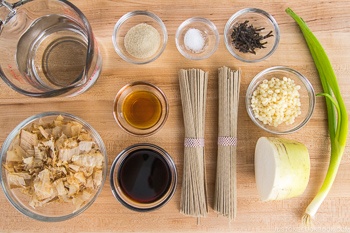
- In a medium saucepan, add 1½ cups water and heat until nearly boiling.

- Add 1 cup katsuobushi (dried bonito flakes) and let it simmer for 15 seconds, and then turn off the heat. Set aside and let the katsuobushi steep for 15 minutes.
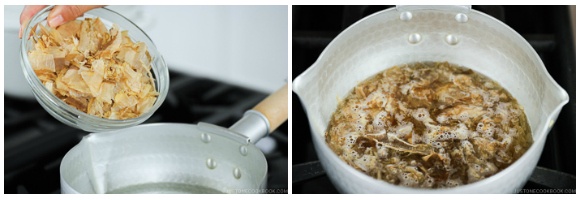
- Meanwhile, peel the skin of 7 oz daikon radish, grate it (I use a ceramic grater), and set aside.
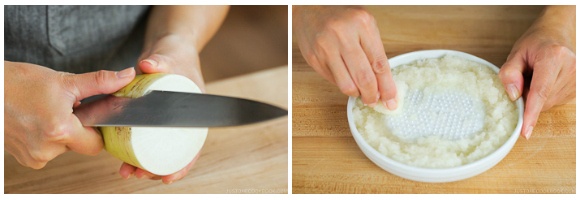
- Cut 1 green onion/scallion into fine rounds.
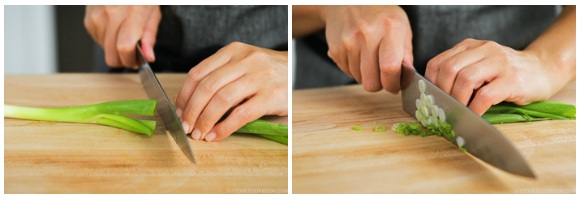
- After 15 minutes of steeping, strain the stock into a measuring cup. You should have 1¼ cups of katsuo dashi. If not, add water.
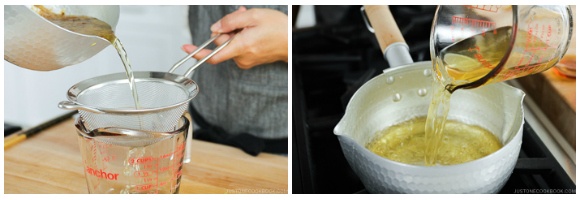
- Add 1 Tbsp mirin, 1 Tbsp sugar, and 3 Tbsp soy sauce. Bring it to boil on medium heat and turn off the heat.

- Mix well and taste it. If necessary, season with ¼ tsp Diamond Crystal kosher salt.
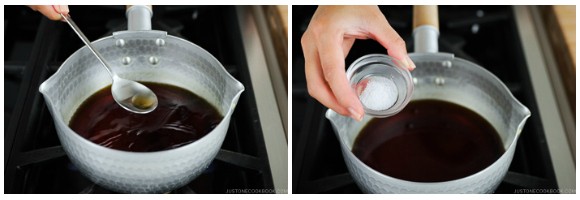
- Place the pot in iced water to cool the sauce down before transferring to the refrigerator (if you are planning to serve later on).
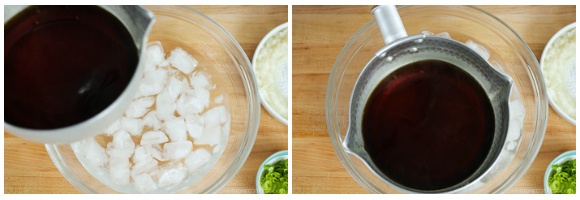
To Cook the Soba
- Bring a large pot of water to a boil. For cooking soba noodles, we do not salt the water. Also, remove the paper bands on 6 oz dried soba noodles (buckwheat noodles) ahead of time. To cook all the soba equally, it’s best to prepare and have it ready to go.
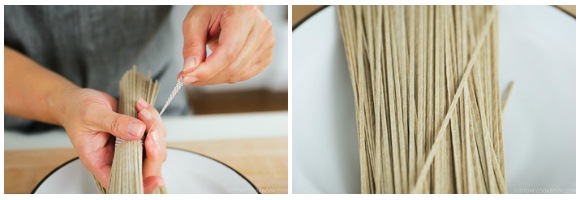
- Once the water is boiling, add the soba and quickly stir so the noodles don’t stick to each other. Cook the soba noodles according to the package instructions. Keep the water boiling on medium to medium-high heat.
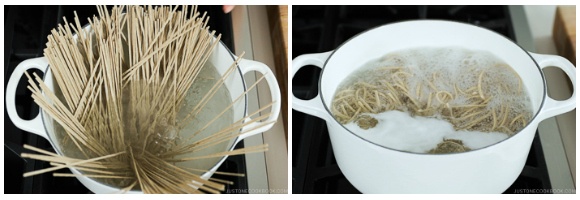
- Drain the soba noodles (you can reserve the soba cooking water called sobayu for drinking). Rinse the soba noodles well under cold water to remove the starch.
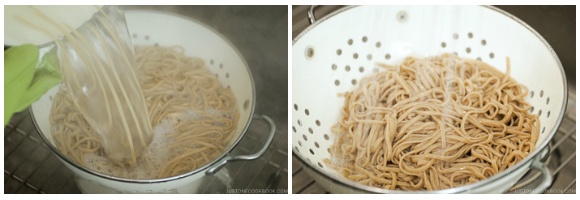
To Serve
- Serve the noodles in individual dishes, and divide the sauce.
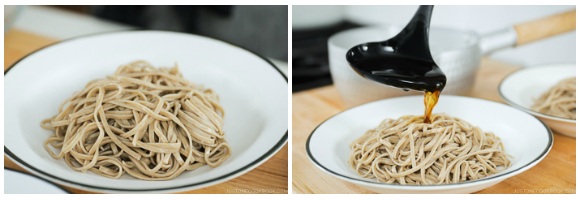
- Now, prepare the toppings. Gently squeeze the grated daikon and place on top of the noodles. (Don’t squeeze too hard and save some moisture so it’s more refreshing, but too much liquid will dilute the sauce.) Top with ½ cup katsuobushi (dried bonito flakes), 3 Tbsp tenkasu/agedama (tempura scraps), the sliced green onion, and 1 Tbsp shredded nori seaweed (kizami nori). Serve immediately.
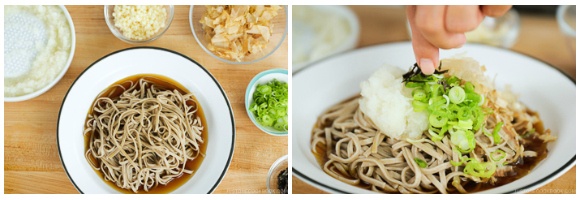
Nutrition
Did you make this recipe?
Tag @justonecookbook on Instagram so we can see your delicious creation!


